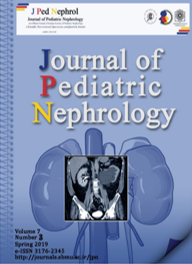Background and Aim: Cardiovascular disease (CVD) has been recognized as a major cause of death among children with end-stage renal disease (ESRD). Matrix metalloproteinases (MMP-2 and MMP-9) and endothelial dysfunction play a significant role in the development of CVD in these children. This study was conducted to assess the association of MMP-2 and 9 and endothelial dysfunction markers (sE-selectin and brachial flow mediated dilatation (FMD)) with carotid intima media thickness (c-IMT) and left ventricular mass index (LVMI).
Methods: Thirty-one pediatric ESRD patients and 18 healthy controls were included in this research. The case and control groups were matched in terms of sex and age. Serum levels of MMP-2, MMP-9, sE-selectin, and other biochemical parameters were measured. Brachial FMD, c-IMT and LVMI were also measured in the two groups.
Results: C-IMT had a positive correlation with diastolic blood pressure, MMP-2, MMP-9, low-density lipoprotein (LDL), triglyceride, phosphorus, PTH, and calcium × phosphorus (Ca × P) product, and a negative correlation with FMD, high-density lipoprotein (HDL), and calcium. LVMI demonstrated correlations with systolic blood pressure, MMP-2, FMD, cholesterol, triglyceride, HDL, phosphorus, PTH, and Ca × P product. The area under the curve (AUC) in ROC curve analysis was used to determine the abnormal c-IMT and LVH values for MMP-2, which was 0.76 and 0.71, respectively (p<0.05).
Conclusion: C-IMT and LVMI are two major CVD markers in pediatric ESRD patients. These two markers correlated with MMP-2, MMP-9 and endothelial dysfunction markers. According to this study, MMP-2 may determine abnormal c-IMT and LVH in ESRD children.
Keywords: End-stage renal disease; Cardiovascular disease; Left ventricular hypertrophy; Atherosclerosis; Matrix metalloproteinases.

